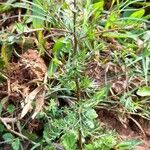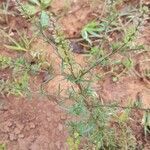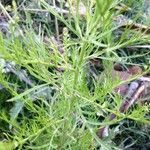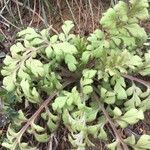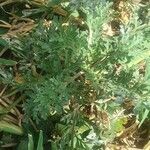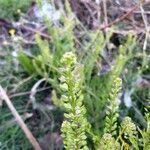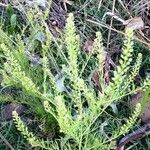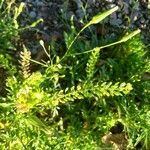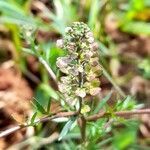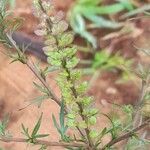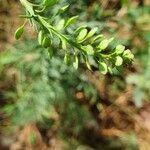Erect herb usually not branching from the base, 15-60 cm high. Stem densely hairy or puberulous, leafy. Basal leaves rosulate, petiolate, bipinnatipartite, densely hairy. Upper leaves pinnatifid, thinly hairy or puberulous, glabrescent. Racemes terminal, later apparently leaf-opposed, as they become overtopped by lateral shoots; rhachis hairy or puberulous. Pedicels erect-arcuate, in fruit 3-6 mm long. Sepals 0.8-1 mm long, oblong, green, often tinged with purple, margins membranous, puberulous when young. Petals 0.1-0.8 mm long, linear or subulate-lanceolate, white. Stamens 2; filaments subulate. Nectaries small, triangular-rounded. Siliculae 3-3.5 x 2.6-3.2 mm, obovate or subcircular, emarginate with small apical wings; style very short, included in the sinus. Seeds 1.5-2 x 0.9-1.2 mm, semi-ovoid, very narrowly winged on the outer, rounded margin, minutely papillose.
Annual or biennial. Stem erect, branched above, hairy, (10)-20-45-(90) cm tall. Lvs hairy. Basal and lower stem lvs falling at flowering, 2-3-pinnatisect with linear segments, (2)-3-10 × 1-4 cm; petiole expanded at base, < lamina. Upper stem lvs becoming sessile, pinnatifid, 1-3 × 0.5-1.5 cm. Racemes 5-15-(30) cm long; rachis hairy; pedicels hairy, spreading, 2.5-4 mm long at fruiting. Sepals with long tangled hairs or glabrous, 0.5-1 × 0.3-0.5 mm. Petals white, linear, much < sepals or 0. Stamens 2. Silicle circular or broadly elliptic, 2.5-3.5 × 2.5-3.5 mm; style free from the narrow wing, c. 0.1 mm long, not protruding beyond the apical notch; valves glabrous with fine veins when ripe. Seeds brown, ovoid, winged, c. 1.5 mm long.
A cabbage family herb which either re-grows each year or can take 2 years to complete its life cycle. It grows 50 cm high. The stems are erect and branched. They are hairy. The leaves at the base have leaf stalks. These leaf blades are divided into 2 or 3 leaflets along the stalk. The leaves are 3-10 cm long and 1-4 cm wide. The lobes are narrow. The stem leaves become smaller up the stem. They do not have leaf stalks. The leaves are deeply divided or toothed. The flowers are dense. The petals are narrow and white. The fruit develop along the flowering stalk from the bottom up. Their stalks are 2-3 mm long. The dry pods are short and 2.5-3.5 mm long. The seeds are broadly oval and 1.5 mm long.
Annual or biennial herb to 50 cm high, erect, puberulous with weak or reflexed hairs. Basal leaves bi-to tri-pinnatisect, to 8 cm long, the lobes up to 2 mm wide; cauline leaves reducing, pinnate to serrate, puberulous, the marginal hairs somewhat sabre-like. Inflorescence a dense, elongating raceme. Sepals c. 0.5 mm long. Petals shorter than sepals, white. Stamens 2, median. Stigma subsessile. Silicula dehiscent, broadly ovate, 2–3.5 mm long, 2–3 mm wide, glabrous; wing narrow in upper half, forming shallow open notch approximately one-eighth length of fruit; pedicels 2–3 mm long, puberulous on adaxial surface, ascending. Seeds c. 1.5 mm long; radicle incumbent.
Annual herb, 0.15-0.60 m high, erect, not branching from base. Stems puberulous, leafy. Leaves: basal leaves rosulate, petiolate, bipinnatipartite, densely hairy; upper leaves pinnatifid, puberulous, glabrescent. Inflorescence a terminal raceme; rachis hairy or puberulous. Sepals oblong, green, often tinged with purple, margins membranous, puberulous when young. Petals linear or subulate-lanceolate, white. Nectaries triangular-rounded. Fruit a silicula, obovate or subcircular, emarginate with small, apical wings. Seeds semi-ovoid, margins narrowly winged, rounded, minutely papillose.
Annual herb, up to 0.6 m high. Stems erect; leafy; densely hairy or puberulous. Leaves with basal leaves rosulate, petiolate, blade bipinnatipartite, densely hairy; upper leaves pinnatifid, puberulous or glabrescent. Flowers: in terminal racemes, later apparently leaf-opposed as they become overtopped by lateral shoots; stamens 2; nectaries triangular-rounded; petals linear or narrowly subulate-ovate, 0.1-0.8 mm long, white; Jun.-Nov. Fruit with pedicels erect-arcuate; siliculae obovate or subcircular, 3.0-3.5 x 2.6-3.2 mm, emarginate, with small apical wings.
Erect herb, up to 0.6 m high. Basal leaves bipinnatipar-tite, densely hairy; upper leaves pinnatifid, puberulous or glabrescent. Siliculae emarginate, with small apical wings. Flowers white.
Silicule up to 3.5 x 2.8 mm., broadly elliptic to suborbicular, slightly winged at the apex and clearly emarginate with the remains of the style included in the emargination.
Lower cauline leaves up to about 7 cm. long, pinnatipartite to bipinnatipartite, petiolate, pubescent; upper leaves pinnatipartite to subentire with 2.4 acute teeth.
Flowers greenish-white at first, pedicellate, pedicels 1–2 mm. long, in dense corymbose racemes elongating later until up to 17 cm. long.
Annual or perennial herb up to about 50 cm. tall with a single, erect rather sparsely and minutely pubescent stem.
Seeds 1.5 x 0.9 mm., orange-brown, flattened-ellipsoid, with a narrow hyaline margin.
Petals minute, less than 0.5 mm. long.
Sepals c. 1 mm. long.
Stamens 2.
